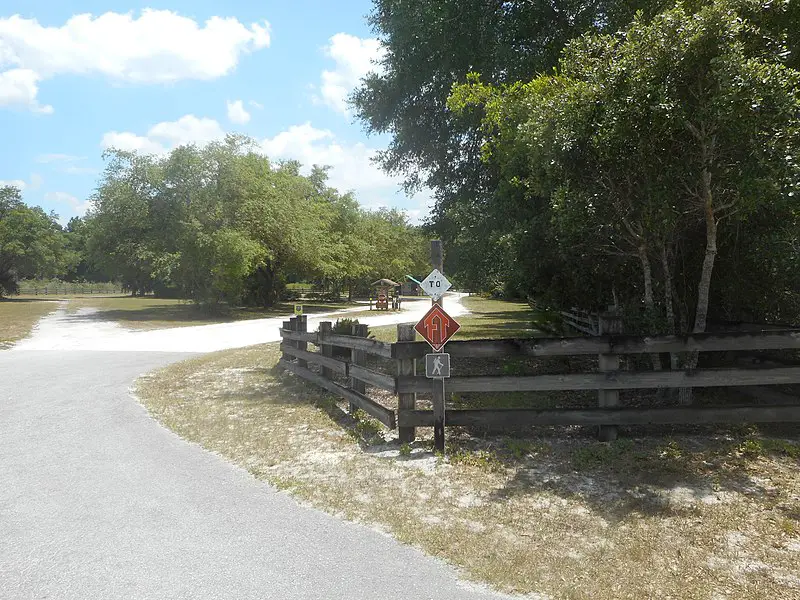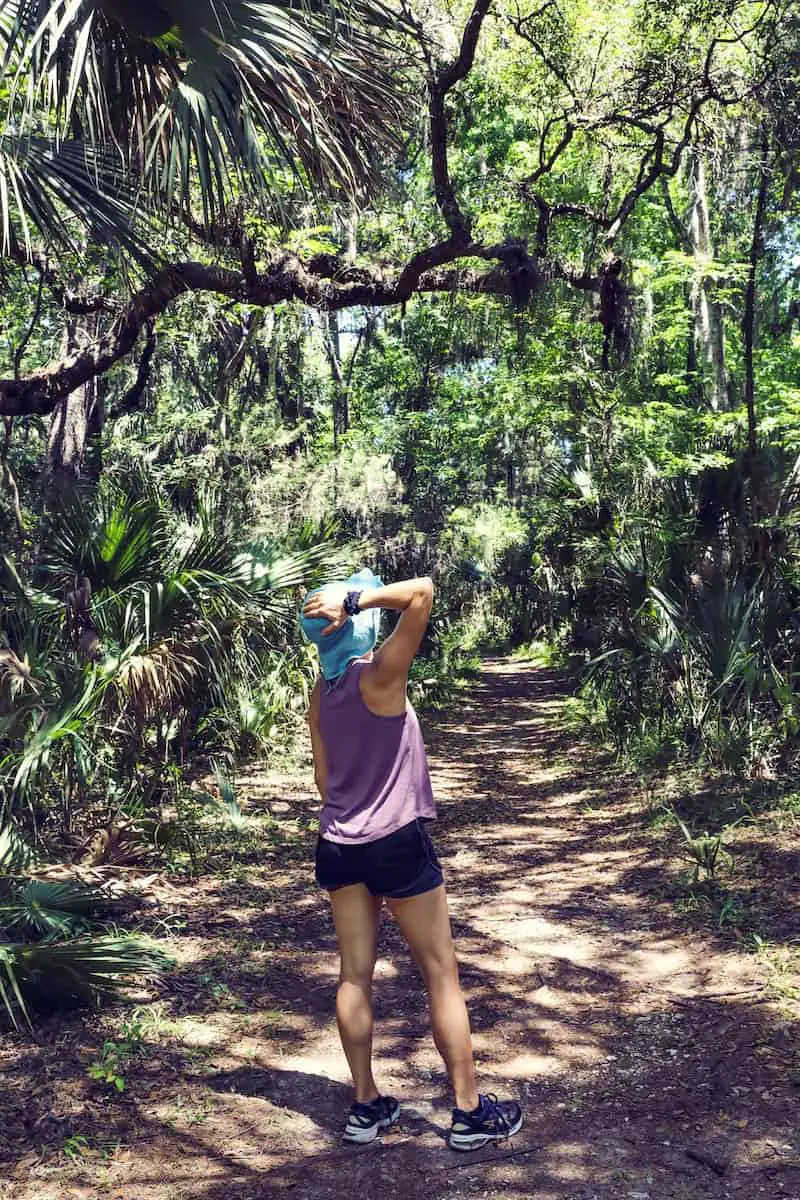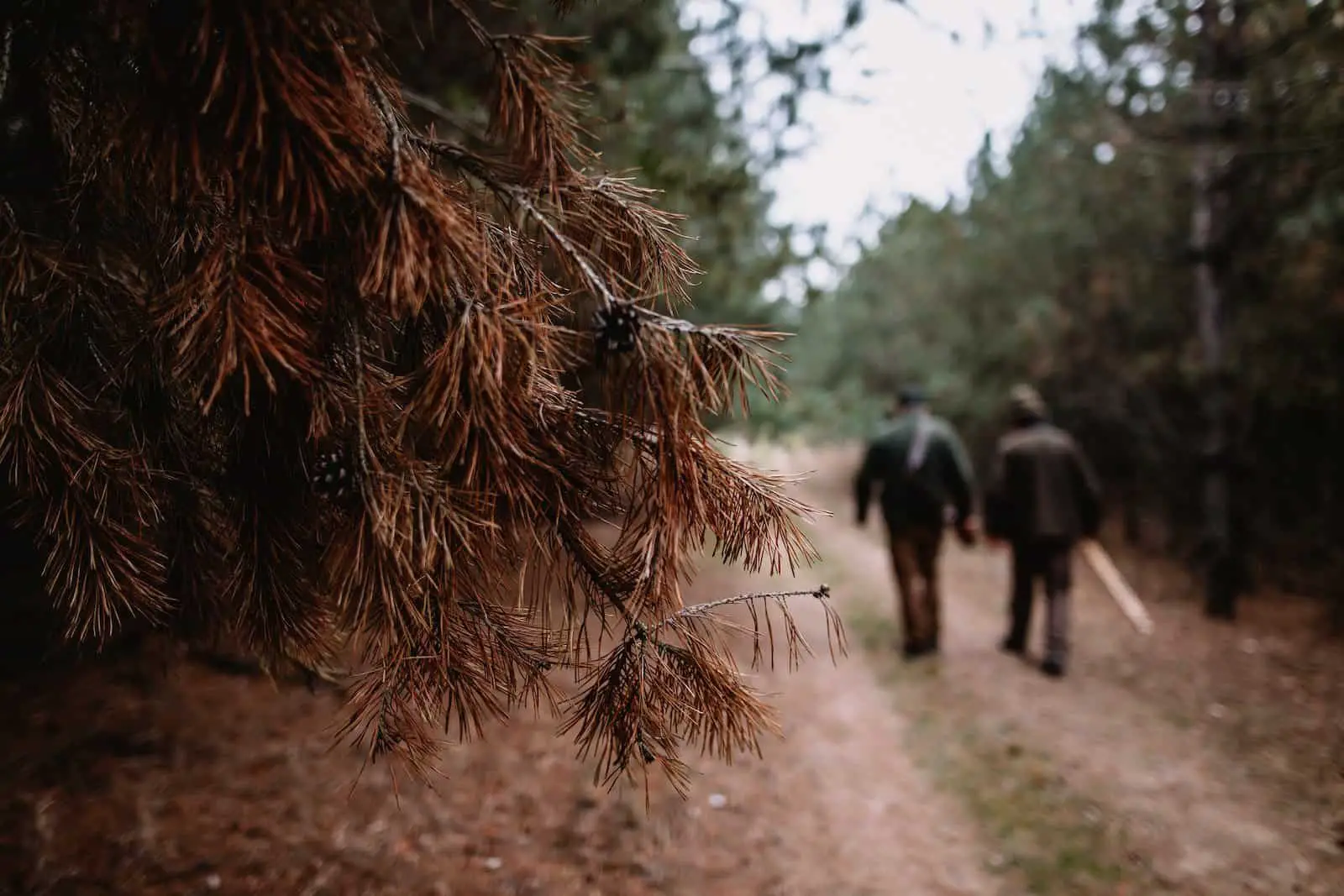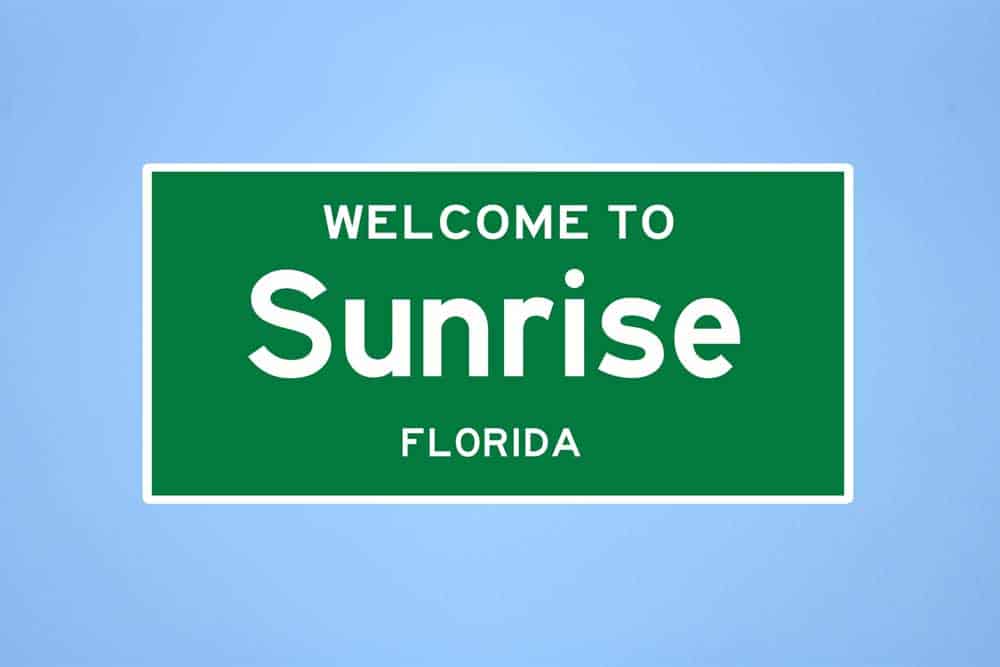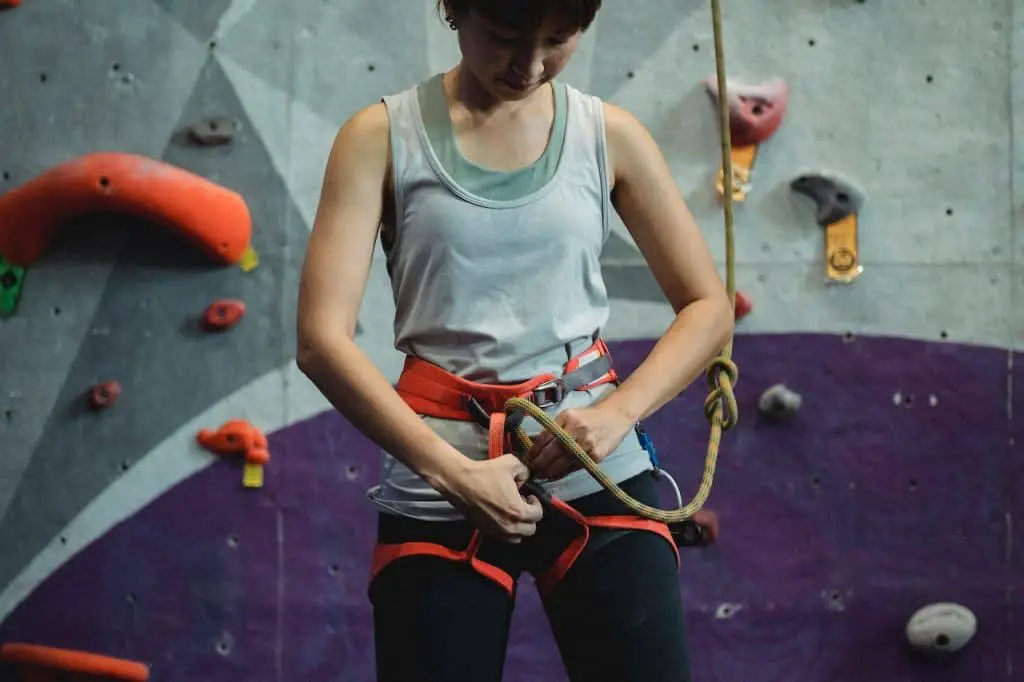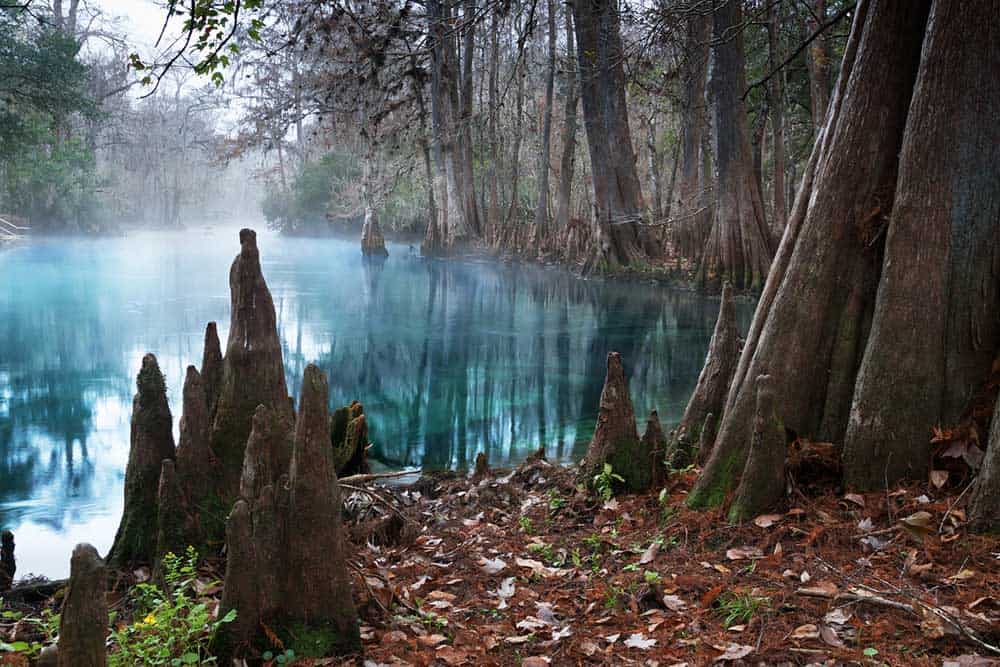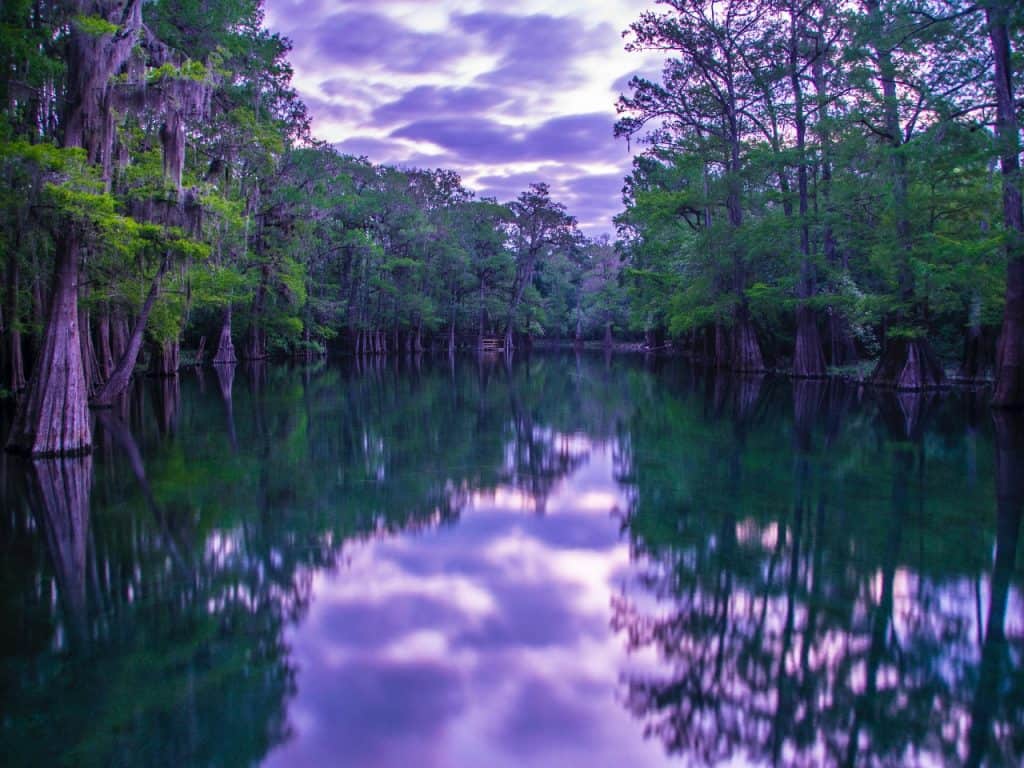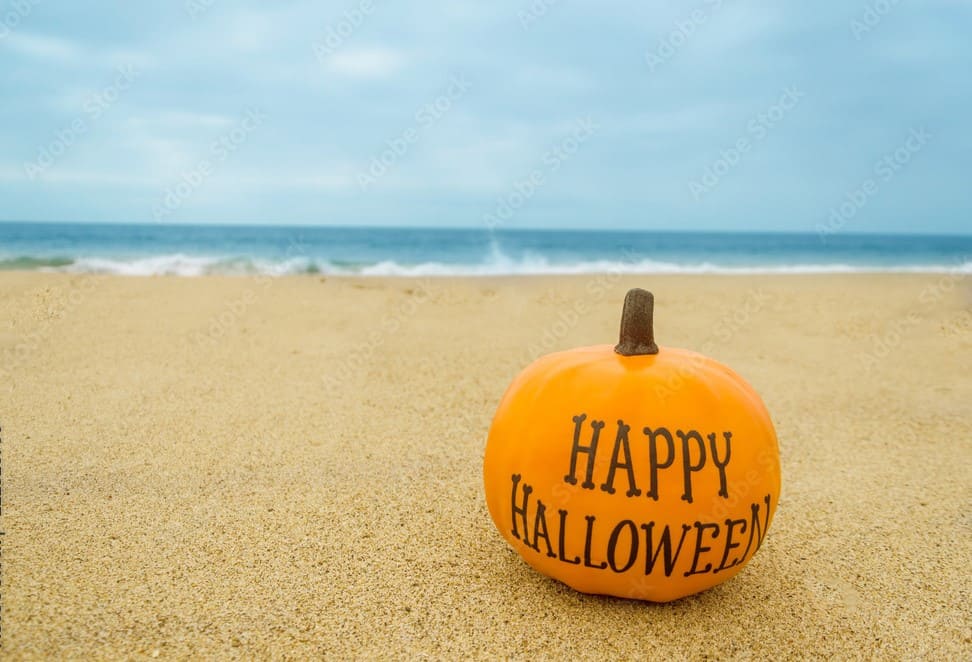Deep in the heart of Central Florida lies a hidden gem waiting to be discovered – Seminole State Forest. This beautiful forest is home to over 300 lakes, rivers, and streams as well as diverse wildlife and plant life.
With so much to offer, it’s no wonder that Seminole State Forest is one of the best-kept secrets in Florida.
Located 12 miles east of Eustis on State Road 44, Seminole State Forest is one of the most popular areas in the state to hike.
This 25k-plus-acre forest has a wide variety of recreational activities. The forest is also a keystone in the greenbelt that links the Wekiva River Basin to the Ocala National Forest.
The forest is protected by the Florida Fish and Wildlife Conservation Commission. The agency regulates hunting in the forest. Hunting is only allowed during the spring turkey season and the fall deer season.
The forest is also protected by the Save Our Rivers program, which protects habitat for endangered species. The Florida Trail and Florida National Scenic Trail pass through the forest.
The Wekiva River Basin contains the Seminole State Forest. The ecological richness of the Seminole Forest, which encompasses nearly all of the naturally occurring vegetative groups found in Central Florida, is what gives it its distinctive character.
There are more than 18 different types of natural communities, each with its own set of flora, fauna, and physical traits.
Flatwoods, scrub, blackwater streams, and bottomland forests are a few examples. Nationally recognized as a wild and scenic river system are the Wekiva River and Black Water Creek.
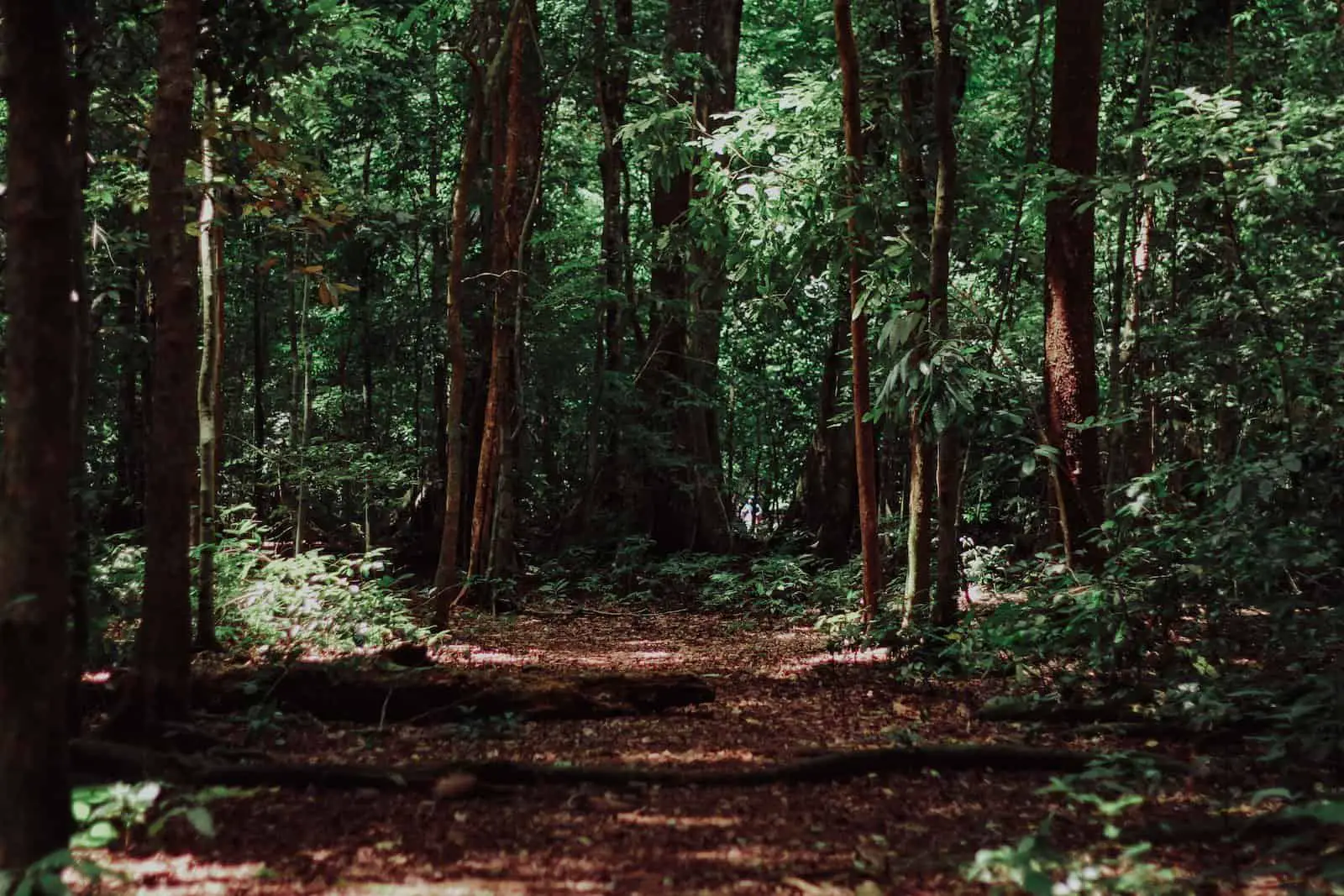
Primitive camping, hiking, biking, horseback riding, wildlife viewing, fishing, and hunting are just a few of the recreational activities available.
Seminole State Forest is a crucial component of a wildlife corridor that runs from the outskirts of Orlando to the Ocala National Forest.
There is constantly wildlife here. It is one of the locations closest to Orlando where you are most likely to witness a bear. The southern end of this trip passes through a vast ecosystem of scrub that is home to Florida scrub jays.
In the wide plains next to Boggy Creek Lake, flocks of turkeys and sandhill cranes congregate.
From the wide pine Flatwoods to the profoundly shadowed floodplains, you may catch a deer off guard in almost any place.
Access to the forest’s interior is made possible by a network of graded forest roads, but some of these may have soft sand or puddles.
Seminole State Forest hosts seasonal hunting; therefore, confirm dates well in advance. If you prefer to hike during hunts, wear bright orange.
The hunters here prefer that you avoid the woods on the few available hunting dates.
For usage of the four campsites along the Florida Trail and the Lower Wekiva Loop, hikers must pay an extra nightly fee.
In this location, bears are commonly sighted. Use a bear canister or bear bag, which we implore you to do.
The Florida Trail through this portion offers a simple escape from the Orlando metro area into a wonderfully varied terrain with numerous campsites. Diverse and fascinating.
Directions
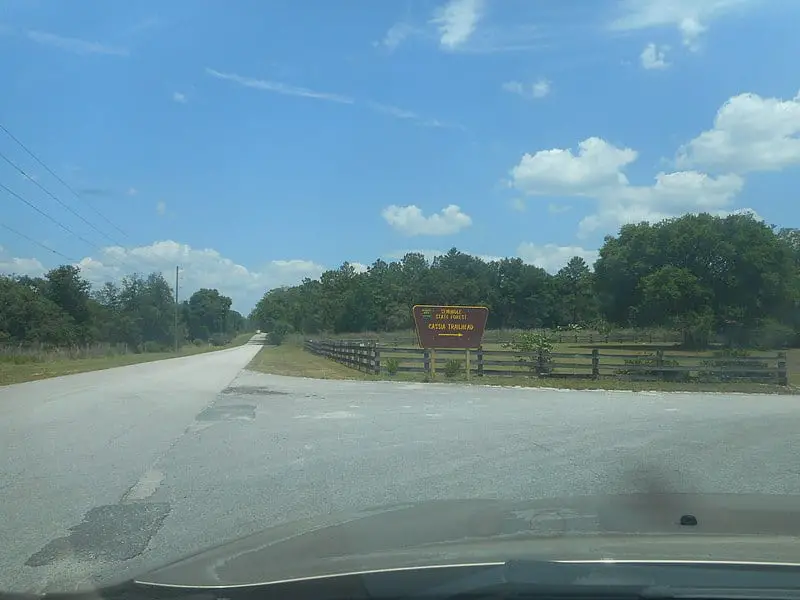
Bear Pond trailhead: Take SR 46 west for 5.2 miles from Interstate 4 exit 101C in Sanford. Search for the Seminole State Forest entrance on the right after crossing the Wekiva River.
After traveling 0.3 miles on the forest road, park on the left after stopping at the self-service kiosk to pay the $2 day usage fee.
Cassia trailhead: From Bear Pond, travel west on SR 46 for another 2.2 miles to the intersection with SR 46A.
This is the northern trailhead for this section. SR 44 will take you 5.6 miles north to the traffic light. By turning right, you can go 5.1 miles east on SR 44 until you reach Brantley Branch Road. Go right. On the right, there lies the Cassia trailhead.
Hiking Seminole State Forest
Trails
The Florida Trail is a network of 65 miles of hiking trails. It passes through the Big Cypress National Preserve and through Seminole State Forest.
It offers a wide variety of botanical diversity and unique sites. It is ideal for a beginner hiker. The Florida Trail includes a series of primitive campsites. It is also the only segment of the Florida National Scenic Trail to have walk-up campsites.
Seminole State Forest has several recreational trails, including a 7.5-mile section of the Florida National Scenic Trail. It also offers three named hiking loops.
The Collier-Seminole Hiking Trail is a rugged 6.5-mile loop. The trail passes through the largest natural hammock of royal palms. It is also home to colorful terrestrial orchids.
The Florida Trail continues north-northwest through the Cassia section of the forest. The loop features yellow blazes.
This loop is a 7.2-mile round-trip. The trail also passes through the Lower Wekiva Loop, which is maintained by the Florida Trail Association.
Starting from the Bear Pond trailhead, proceed past the kiosk where you can make a campground reservation and through the opening in the fence (and pay a fee for it). Oaks slant over the footpath beyond a brief section of pine Flatwoods, providing shade.
You pass a bridge across a brook after 0.5 miles. For Shelter Camp, which is another quarter mile away, this is a water supply.
It offers a sizable sleeping area and a lovely clearing for tent camping, making it one of the few shelters along the Florida Trail.
A trail registration is located in a mailbox at the intersection with the Lower Wekiva Loop, a detour that goes closer to the Wekiva River floodplain, just past Shelter Camp. Continue following the orange blazes after signing in.
Florida scrub jays are most likely to be seen in this section of scrub woodland that the trail traverses.
Also, look for bear footprints in the sand. At 2.2 miles, the trail crosses East Spur Road, a graded forest road, and arrives at a wide prairie ecosystem.
The trail turns northwest and the scenery continues to the far horizon.
The trail parallels Main Grade Road, the main north-south vehicle access through the forest, and crosses a short bridge over a transient wetland in the scrubby Flatwoods after it.
As you merge with Main Grade and head north across Black Water Creek’s floodplain, you pass the Lower Wekiva Loop’s approaching blazes on your right.
Blue blazes that descend to Blackwater Creek Camp, which is perched on a bluff above the creek, are visible in their wake. Cross Black Water Creek on the wide vehicular bridge at 3.9 miles.
One of the largest rivers feeding the Wekiva River is this creek. On the other side of Sand Road, the route continues, sweeping past a picnic table with a lovely view of the creek.
A horse trough and a kiosk are located at a crossroads. Follow the orange blazes into the trees while staying to your right. For a while, the trail travels alongside an old railroad tramway.
The trail runs parallel to a forest road after passing a dry prairie pond.
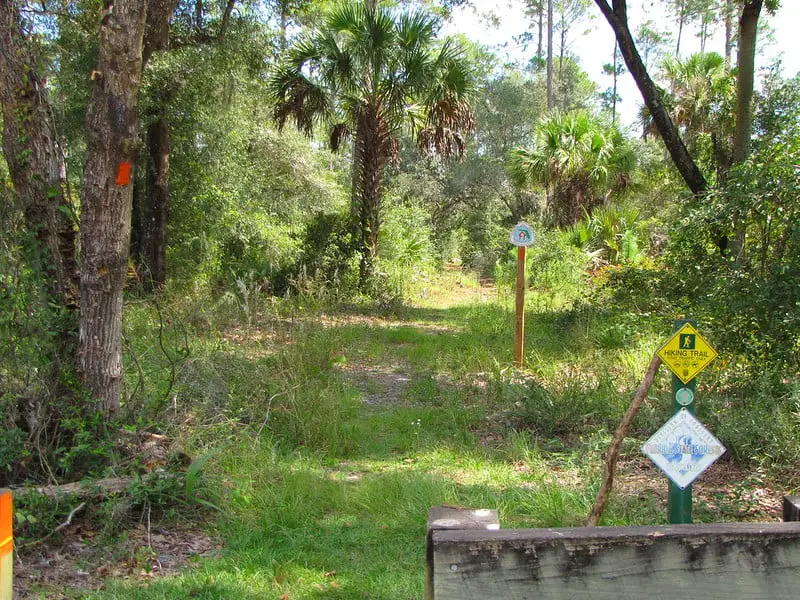
You emerge from a narrow saw palmetto tunnel onto another old tramway that was formerly used to log the massive trees from this forest more than a century ago.
As you cross a forest road and reach another section of sand pine scrub, be on the lookout for blazing across the following section.
The Trail walker Trail’s Sulphur Island Loop is met at the trail’s blue-blazed intersection as it makes its way back to the road. At 5.2 miles, you reach Sulphur Camp by crossing the street.
It is a clearing with picnic tables that is easily accessible to guests traveling in cars. Look to your right as you pass through it for the blue blaze. It’s worthwhile to detour down it.
The blue blaze descends, getting ever narrower until it comes to Shark Tooth Spring’s crystal-clear canal. The Seminole State Forest is home to numerous springs, though you won’t encounter them along the main routes.
The trail terminates at the base of the spring, which, like Rock Springs nearby, flows directly out of rocks at the base of a cliff, so keep going up the path until it reaches there.
Seminole State Forest Primitive Campsites
Located in the heart of central Florida, the Seminole State Forest is a popular hunting and recreation destination. This forest also is home to a diverse array of wildlife, including deer, hogs, bears, turkeys, quail, and raccoons.
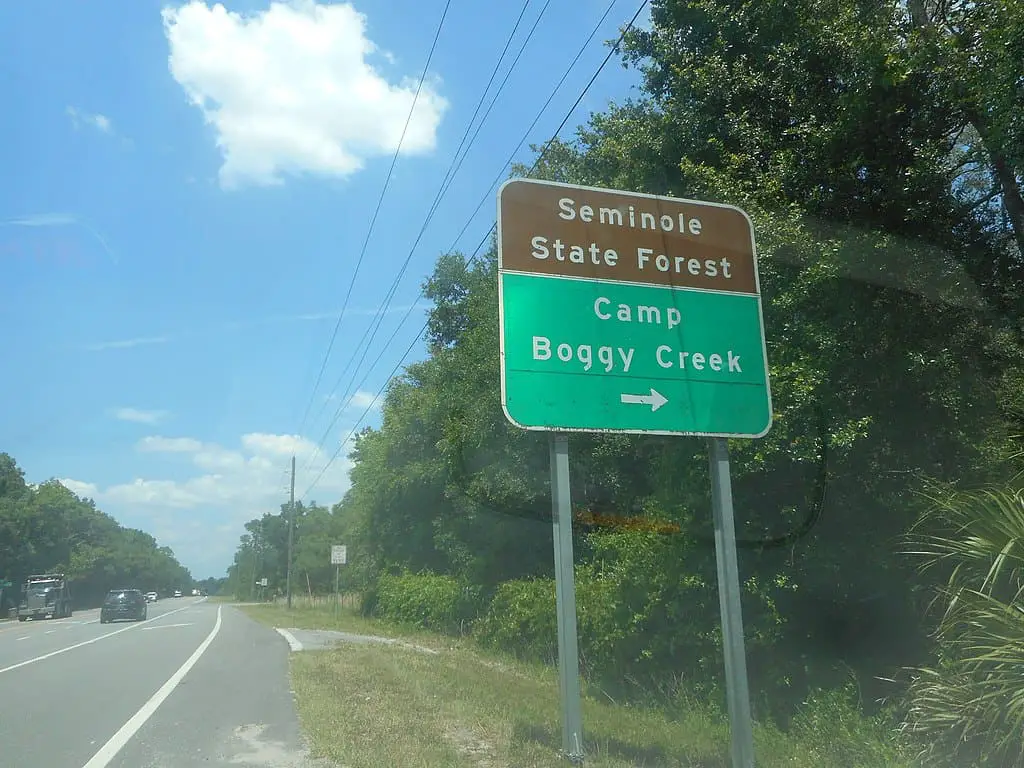
Water Access
The area is also home to many springs. It is important to disinfect the water before drinking it. A water filter is also recommended. You’ll be required to bring your own water filter or sterilize the water before you drink it.
These campsites do not have electricity. Several other primitive campsites are also available on a first come, first served basis. You can also reserve a site by calling Lake Forest Station.
The Bear Pond Trailhead is located off of State Road 46 and the Cassia Trailhead is off of Brantley Branch Road. Both trailheads have parking.
The Cassia Trailhead provides parking for up to eight to ten vehicles. It has a restroom and a temporary bathroom. A large picnic pavilion is also available at this trailhead.
The Black Water Creek Campsite is next to Black Water Creek and is accessible through a paddling trail. This camp has a picnic table and a fire ring. During high water, this campsite may be closed. During the hunting season, all campsites are closed.
The Moccasin Springs Camp is next to Blackwater Creek and has room for five people. The campsite has a fire pit and parking. The Florida National Scenic Trail runs through the forest and passes by the Sulphur Camp.
A bridge crosses Blackwater Creek. There are brown-headed nuthatches in the area. During the spring, you can also find Indigo Buntings.
There are three primitive campsites at Davenport Landing. This former steamboat stop is along the Ocklawaha River and has light usage. The campgrounds are free. The maximum stay is four days.
There are four named hiking trails at Seminole State Forest. Each provides a different experience. The Florida Trail is the main hiking trail, which connects to the Cassia Trailhead in the north and the Bear Pond Trailhead in the south.
Fishing
Fishing is permitted in the Seminole State Forest Wildlife Management Area.
Lake Seminole is an excellent fishing location. You can fish in the lake and in the nearby rivers. The river forms a natural border with northwest Florida. Fishing is also permitted on Bear Pond, a 13-acre pond that is kept stocked with game fish.
A brochure issued by the Florida Fish and Wildlife Conservation Commission provides a comprehensive guide to the area’s regulations.
Seminole State Forest is part of the Wekiva Wild and Scenic River System, an outstanding Florida water system. The Wekiva River forms the eastern boundary of the forest.
It’s designated as Outstanding Florida Water and is a tributary to the Chattahoochee River. Fishing in the river is permitted. There is also a canoe/kayak launch at the Blackwater Creek Trailhead.
The Apalachicola River eventually flows into the Gulf of Mexico. The lake has a shoreline of 2.5 miles. You can also enjoy boating.
Hunting
Hunting is allowed in this area, but it is restricted to spring turkey season and fall deer season. Hunting permits are required, and the Florida Fish and Wildlife Conservation Commission publishes area regulations.
There is also a brochure available that includes hunting season dates, hunting fees, and a map of the area.
If you’re looking for hunting at Seminole State Forest Primitive Campsites FL can find plenty of wildlife. In addition to sandhill cranes, white-tailed deer, and black bears, there are also otters, eastern indigo snakes, and Scrub-jays.
Bears
Whether you’re camping at Seminole State Forest primitive campsites FL or somewhere else in Florida, bears can be an unpleasant surprise. Bears can be territorial, solitary creatures that will not hesitate to attack you. This is why you should “Be Bear Aware” before you leave for a wilderness experience.
The Florida Fish and Wildlife Conservation Commission is a good source of information about bears.
You should also remember to pack bear-resistant garbage receptacles. This is important to keep bears away from your food. Also, keep food stored away from tents. This should include airtight containers.
Also, make sure you have bear repellent and EPA-registered bear pepper spray. This is particularly important if you’re camping in bear country.
If you see a bear, you should back up slowly, speak in a calm voice, and make noise. You should also keep your arms straight, as bears can intimidate you.
- You should also take precautions against intense summer heat. You should also lock all doors to your tent at night. Also, you should close curtains that might give bears a glimpse of your food.
- If you’re traveling with a dog, you should always leash your dog. You should also stay away from fights.
- You should also store your food in bear-resistant containers at least 10 feet above the ground. Bears will eat anything that smells good. You should also store your food in a locked vehicle.
- During hunting seasons, all campsites are closed. But there are still five primitive campsites available for hikers on a first-come, first-served basis. You can reserve these campsites by calling Lake Forest Station.
You can also access the Florida National Scenic Trail from three walk-up campsites. The trails in Seminole State Forest connect to 20 miles of maintained trails in the Lower Wekiva River Preserve State Park.
This area is a great place for families to enjoy nature study, hiking, and wildlife viewing. The Florida Trail also offers opportunities for cycling, fishing, and canoeing.

